Technique of Mud free eel farming allows farmers to raise eels without the need for muddy ponds or tanks, which can be difficult to maintain and can negatively affect eel health. This technique involves using a small tank, usually made of cement or plastic, and a special feeding method that promotes eel growth and minimizes waste.
The key to mud-free eel farming is providing the right environment for the eels to thrive. The tank should be filled with clean, oxygenated water that is changed regularly. The water temperature should be maintained at a consistent level, ideally between 25-28°C, which is optimal for eel growth.
Where can apply Technique of mud free eel farming
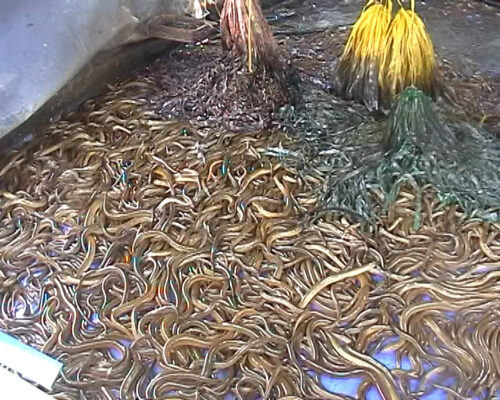
Location for farm
- Choose a quiet location with little traffic and shaded areas.
- Choose a location that is slightly elevated, open, and free from storms and floods; a place with different types of soil such as loam and sand.
- Ensure an abundant, convenient water source with good water quality and a certain gradient for water drainage.
Constructing the eel tank:
The shape and size of the tank depend on the scale of eel farming. A small tank with an area of 10-30 m2 is suitable, with a depth of 0.7-1 m. The tank can be either floating or made of sunken cement, as long as the principle of preventing eels from escaping, facilitating capture and water drainage is well understood.
There are two main types of eel tanks:
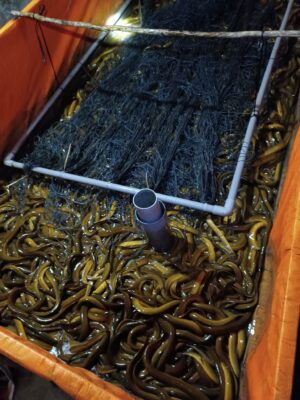
Liner tank
- The liner tank is laid on a flat ground, with sand evenly spread before laying the liner to prevent damage; the right bank is made of solid earth or bricks.
- The rectangular tank is the most suitable, with the height of the tank wall compared to the water level in the tank from 40 – 60 cm.
- The tank banks should be raised with a rim or a net to prevent the eels from escaping, especially during rainy days.
- The supply and drainage pipes are independent, with overflow pipes and mesh screens.
- The water source taken into the tank must pass through a filter bag.
- To provide hiding places for the eels, a substrate is made of nylon strings, branches (corn, grass, green beans dried in the sun, etc.), or plastic pipes. The substrate layer is 20 – 30 cm high, and the water level in the tank is the same as the substrate layer.
- A mesh cover is used above the tank to reduce light.
Cement tank
It is possible to utilize a water tank or a pigpen by repairing it to make a tank for raising eels. If building a new tank, it should be partially submerged with a height of about 0.6-1m and an area from 6-20m2. The tank should have a rectangular shape with a width of 2-4m for easy maintenance.
- The inlet and outlet pipes should be independent, and there should be overflow pipes, with screens installed in the pipes.
- The water source for the eel tank should pass through a filter bag.
- To provide hiding places for the eels, nylon ropes, cornstalks, dried grasses, or bamboo mats, plastic pipes, etc. can be used. The layer of these materials should be 20-30cm high, and the water level in the tank should be equal to the layer of materials.
- Use a mesh shade to reduce sunlight above the tank.
Preparation for a mud free eel tank
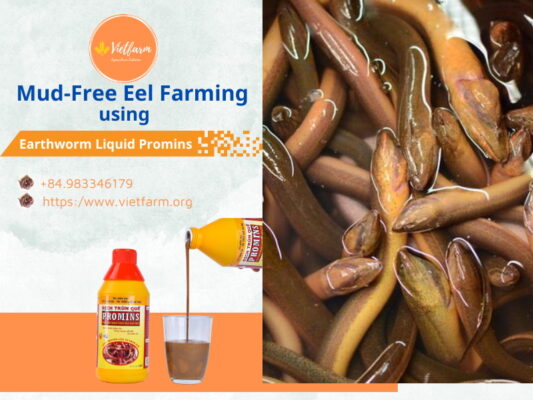
For a new tank:
water needs to be added several times to rinse and check the pH level of the water. (For a newly built tank, it should be rinsed thoroughly, and small pieces of banana tree can be used to soak in the tank to remove the smell of cement).
For a re-use tank
- Drain the water and clean the tank.
- Spread lime evenly on the walls and the bottom of the tank (1kg of lime powder + 10 liters of water) or 10ppm chlorine (1 gram in 1 cubic meter of water) to kill bacteria and adjust the pH.
- Sun-dry the tank for 1-2 days, then fill it with water and soak it for 4-5 hours. Afterward, drain the water and add new water before releasing the eel fry.
- Water circulation: 2 days before releasing the eel fry, fill the tank with water up to the specified level and check the environmental conditions to meet the requirements.Water temperature: 25-27°C.
- pH: 7-8 is appropriate.
- Dissolved oxygen: 2-4mg/l.
Choose and release seedlings in mud-free eel farming.
Currently, the eel farmer is very successful in Artificial eel reproduction. So should to chose the best baby eel for our farm!
Baby eel selection
- Eels with same size, bright color (dark yellow back with black spots), agile movement, without injuries, and not weak.
- Eels with pale, greenish-yellow or grayish color are weak and difficult to raise, with slow growth.
- The quality of seedlings must be good, with a range of 300 – 700pieces/kg.
Eel density in tanks
- The best farming time is from April to September.
- The release density ranges from 500 – 700 pieces/m2.
- Before releasing the seedlings, disinfect the eels with a salt solution of 20-30‰ concentration for 5-10 minutes or with 10-20 g/m3 of purple medicine for 15-30 minutes to eliminate parasites and disinfect wounds caused by catching and transportation.
Daily care for mud free eel farming
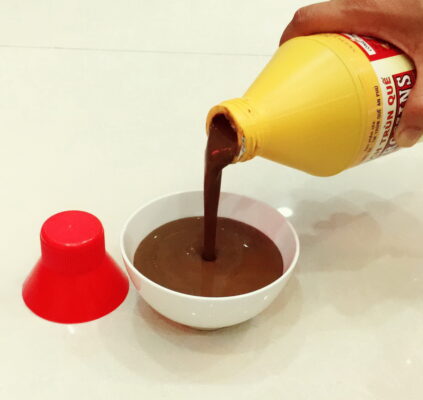
Feeding care for mud free eel farming
- The main food for eels is live or cooked animal carcasses, worms, snails, fish, shrimp… The food can be supplemented with animal protein, plant-based food, and some additives such as mineral premix, vitamins,…
- The food must be fresh and not rotten. The golden apple snails can be used as food for eels, providing high economic efficiency.
- The food is mixed, and before feeding, it should be sterilized with salt (0.5 kg of salt/3 liters of water) for 30 minutes.
- Feed the eels after 3-5 days of releasing. Eels have a high ability to choose their food. Therefore, in the first stage, they need to be nursed and fed with easy-to-find, cheap, and fast-growing food.
- After feeding for about 1-2 hours, check the feeding floor to see the feeding capacity of the eels, then adjust the amount of food accordingly, and clean the feeding floor every time a new batch of food is provided.
- The feeding floor should be located near the drainage ditch so that after the eels finish eating, the dirty water can be drained, and clean water can be provided.
- When there is prolonged rain or hot weather, feeding should be temporarily stopped.
- The eel’s daily food ratio (daily food ratio based on body weight):
- Fresh food (mixed fish, snails, crabs,…): 3-7%.
- Pellet food: 5-10%.
- Ussually use Earthworms liquid Promins as daily additive feed.
Important note when feeding eels
- Consistency: Feeding at the same time every day.
- Moderation: Feeding the right amount of food to avoid wasting it and polluting the water.
- Variety: Diversifying the food types and sources to provide a balanced diet.
- Cleanliness: Ensuring the cleanliness of the feeding floor and removing excess food.
Water care for mud free eel farming
- The average water level in the tank should be from 20-30 cm.
- Regularly check environmental factors such as pH, dissolved oxygen, etc.
- Change water every 2-3 days, with a maximum of 70% of the total water volume. In the summer, with high temperatures, the time for changing water is shorter (1 day per change).
- Every day, collect waste and excess food settled at the bottom of the pond and discharge it outside.
- During prolonged hot weather, measures should be taken to shade the tank. During heavy rain, the overflow pipe should be left open to prevent flooding.
- At night, especially in the hot dry season, if there is a lack of dissolved oxygen in the tank, change the water and operate the air pump to provide oxygen.
Health care for mud free eel farming
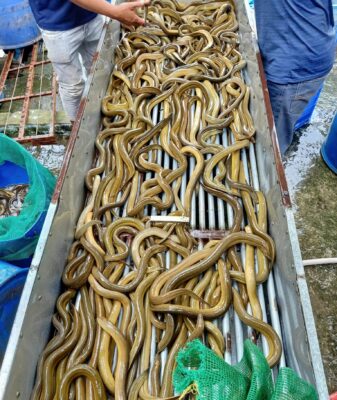
- Observe the activity of eels daily to take timely measures in case of emergencies.
- Remove dead eels and those with signs of illness, slow swimming, or floating head up on the water surface.
- Check the growth of eels: every 30 days, measure the length and weight of 30 eels to calculate the amount of food needed for the next period.
- Check the health of eels: when unusual signs are detected, catch the eels and examine them for any changes in their body. Then, if necessary, dissect them to diagnose their health conditions and take appropriate preventive and curative measures.
Disease care for mud free eel farming
In artificial breeding conditions, eels are prone to diseases that affect their growth and survival rates. Therefore, disease prevention measures must be given top priority.
- It is necessary to disinfect the mud eel seeds, feed, and breeding equipment:
- Before releasing the seeds, bathe the mud eels in a salt solution with a concentration of 20 – 30 ‰ for 5 – 10 minutes or use 10 – 20 g/m3 of purple medicine for 15 – 30 minutes.
- Feed must be cleaned and not fed with spoiled food.
- Clean the feeding floor after each feeding, disinfect the breeding equipment and change the water, monitor the mud eels’ feeding ability, and clean up excess food.
- Regularly monitor the weather, check the temperature, water quality, and ensure clean breeding water. Detect signs of illness or unusual behavior in mud eels in a timely manner to handle and treat them promptly.
Please do not hesitate to contact us for any inquiries regarding product information.
Vietnam Farming.
Hochiminh City – Vietnam
Tel/whatsapp: +84-983346179
Email: vietfarm2002@gmail.com
Youtube: Viet Farming

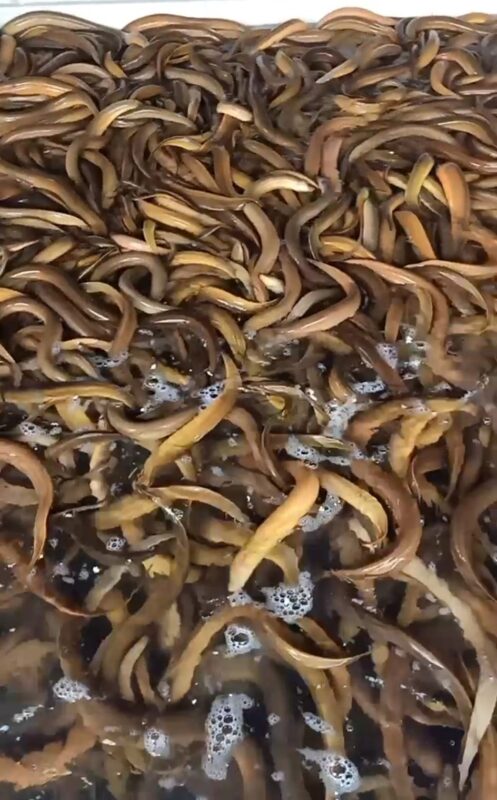
Artificial eel reproduction
ContentsWhere can apply Technique of mud free eel farmingLocation for farmConstructing the eel tank:There are
Food for Successful Eel Farming
ContentsWhere can apply Technique of mud free eel farmingLocation for farmConstructing the eel tank:There are
Mud-free eel Farming
ContentsWhere can apply Technique of mud free eel farmingLocation for farmConstructing the eel tank:There are